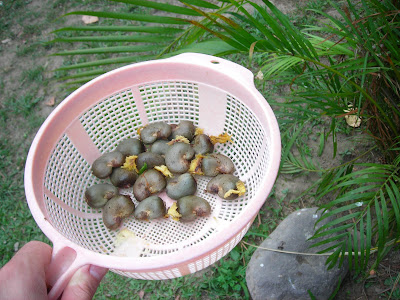STEP 1: Cashew Tree
The first thing you need is a cashew tree. If you don't have one you can borrow one from a neighbor. That's what we did. The tree is sort of smothering the shack behind our house. It rains down 15-25 cashew fruits and nuts everyday.
STEP 2: Pick Fruit
Cashew nuts grow atop a false fruit called a cashew apple, marañón here in Central America. I believe the fruit is called false because it doesn't actually contain the seed of the plant. Cashew apples are extremely sweet and are used to make jellies, chutneys, wines and vinegar. They are the juiciest fruit we have ever seen. After falling from the tree they completely decompose in about three days.
STEP 3: Separate Fruits

Step 4: Gather Nuts
Here we separate the true fruit from the false fruit. The cashew nut is contained in the kidney-shaped drupe that Karine is separating from the cashew apple in this picture. Its best if you can do this before they fall from the tree because cashew apples turn into gloppy messes as soon as they hit the ground.

Step 4: Gather Nuts
We chose this delightful pink plastic strainer to use as our drupe-nut holder. If you don't have a pink strainer you can certainly use anything that will work: a paper bag, a bowl, a differently colored plastic strainer, whatever. We collect nuts every day. As soon as the stainer is full, its roasting time. The roasting process is a little messy and a little dangerous. Better to do them all a once.

WARNING: Before I continue on to the roasting process I would like to remind the reader that this is a description of the stupid way to roast cashews. Cashew drupes contain a caustic dermatogenic phenolic resin called urushiol. This delightful substance, also found in sumac, poison ivy, and poison oak, causes skin inflammation, uncontrollable itchiness, and possibly fluid filled pustules. If you follow my directions exactly, you may just end up covered in this stuff.
STEP 5: Fire up the Grill
Place a handful of drupes on a hot grill and watch them burn. The drupes soon catch fire and begin to ooze thick black oil. I would not recommend doing this roasting, or any roasting for that matter, indoors. As the drupes begin to burn they sometimes shoot out jets of flaming resin. If the flaming cashew drupes get out of control, as mine did, quickly remove them from the flame.




STEP 6: Repeat STEP 5 (Less Heat)

STEP 7: Avoid Smoke

STEP 8: Cooling and Cracking


STEP 9: Wear Gloves (and long pants, and a shirt)

STEP 10: Clean and Re-roast

If your cashew drupes burst into flame and begin exploding, your fire is too hot. You want to the drupes to smoke and sputter resin in a somewhat controlled manner.

STEP 7: Avoid Smoke
Roasting cashew drupes give off a thick white smoke. This smoke is pretty nasty stuff and I would not recommend standing in it or breathing it. Because it is the smoke emitted by boiling urushiol resin I certainly would not recommend getting it in your eye.

STEP 8: Cooling and Cracking
As soon as the cashew drupes are no longer sputtering caustic resin they can be removed from heat for cooling. I never did find a neat and efficient method for separating the nuts from drupes. I used a hammer and my bare hands. This is where I got myself into trouble.


STEP 9: Wear Gloves (and long pants, and a shirt)
If at any time during the cashew roasting process you find your hands covered in urushiol resin (see picture below) you have made a serious error. If you do happen to get urushiol on your hands during the roasting process do not for any reason touch any part of your body unless you want that part of your body to itch for the next two weeks.

STEP 10: Clean and Re-roast
Once the cashew nuts and the cashew drupes have been separated the nuts should be cleaned and roasted in the oven on a low temperature for several hours. This is done to ensure that any remaining urishiol is cooked away.

I learned a lot about nuts through this process. I learned that nuts can be sort of dangerous. One thing that I learned is that, as far as nuts go, cashews deserve a lot of respect. How do they taste? They taste awesome.
The good news is that I don't think I will be breaking out in fluid-filled pustules. My whole body itches pretty much all the time, but I'm happy be pustule free.
The good news is that I don't think I will be breaking out in fluid-filled pustules. My whole body itches pretty much all the time, but I'm happy be pustule free.


5 comments:
guys are pretty much amazing.
That is very, very cool. Can almost smell them from here. Reminds me of harvesting and roasting wild rice from Big Turtle Lake near Bemidji(including stomping on it to remove the hulls).
Yum....those cashews look really good. Don't get downhearted....you will soon come up with a method that better suits and improvise. That was a great post and I enjoyed looking at the actual apple and reading about it's uses. I am Honduras bound in December according to my Catracho.
Very funny post Tom! It was educational too. We go to the Whole Foods store and buy the JUMBO raw cashews. For some reason, they look different from
yours.
Be safe,
Tom in Florida
That is wild. I learned something new. I'm sorry you got the ichies. That must not have been fun.
Post a Comment